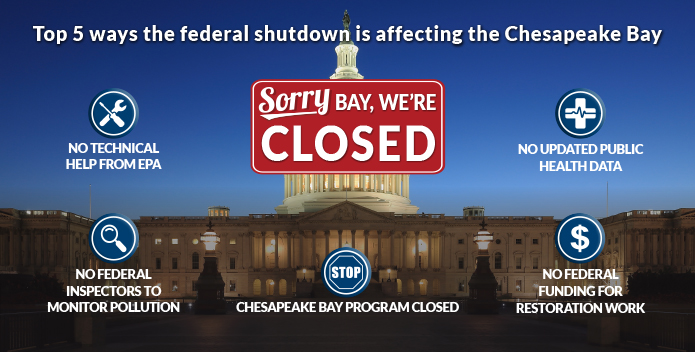Today marks the 33rd day of the Government Shutdown—the longest in our nation's history. Hundreds of national parks are closed; the Food and Drug Administration has stopped doing routine food safety checks; 400,000 federal workers have been furloughed and another 400,000 are expected to work without pay. Clearly, a shutdown has devastating consequences. But what does it mean for the Chesapeake Bay and the critical work needed to restore it?
Here are five things you should know about what this shutdown means for our watershed:
- Implementation of the Phase III Watershed Implementation Plans—critical to the Chesapeake Clean Water Blueprint and Bay restoration—may be delayed because EPA staff is unable to provide needed technical assistance to the jurisdictions during the shutdown.
- Pollution inspectors and other workers who monitor compliance with environmental laws are furloughed which increases the chances that companies might emit illegal levels of contaminants into the air or water without detection.
- All work at the Chesapeake Bay Program—an arm of the EPA that also serves as a partnership of federal, state, and local agencies involved in the work of restoring the Chesapeake Bay—has essentially come to a halt. No decisions can be made because the 19 federal agencies represented in the partnership are closed.
- When the Chesapeake Bay Program office is closed grants are not funded, leading to a lapse in restoration work and unpaid employees.
- Federal agencies such as United States Geological Survey and EPA responsible for a vast network of monitoring stations across the watershed are closed and not able to share valuable public health data.
As our own Lisa Feldt, CBF's vice president of environmental protection and restoration, told Greenwire: "I'm concerned, and the longer it goes on, the more concerned we will get."
There is a huge amount of work left to do to save the Bay. And every day that the EPA and the Chesapeake Bay Program are closed, we take one step backwards from Bay recovery.
With Senate leaders expected to hold competing votes tomorrow on bills to end the shutdown, we're hopeful this will lead to some movement forward—for the sake of the hundreds of thousands of government workers without work and without compensation, for the sake of our food and health, for the sake of our lands and waters, including our Chesapeake Bay, that are so integral to our country's identity and heritage. One can dream at least.

Issues in this Post
Chesapeake Clean Water Blueprint Chesapeake Clean Water Blueprint Politics Runoff Pollution Water Quality CBF in Maryland CBF in Virginia Eastern Shore Office CBF at the Federal Level Hampton Roads Office Maryland Office, Annapolis New York CBF in Pennsylvania Virginia Office, Richmond



